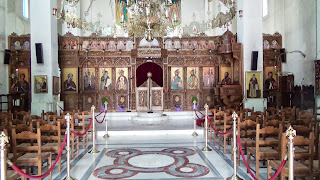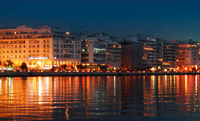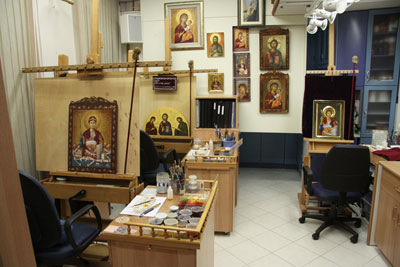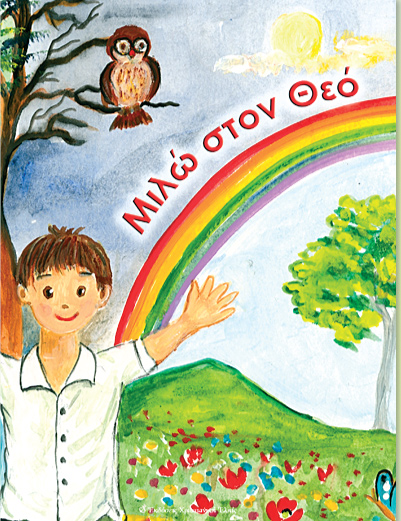Translation from the Book
Ὁ Θεός στήν ἱστορία τῆς Ἐκκλησίας, Βοήθημα Κατωτέρου Κατηχητικοῦ Γ΄,
ἐκδ. «Χριστιανική Ἐλπίς» Ὀρθόδοξη Ἀδελφότητα, Θεσσαλονίκη 2016, σσ. 48-53
 This time, children, I think we’d better meet in our Parish Church. You too, I believe, will be glad to be shown around the house of our God, which is also our house. As each one of us is totally familiar with our home spaces, furniture and position of various things, likewise the children of God would know how to make their way in the house of their Father. So come along today, to get to know a little better the house of our father God, which is also our common home!
This time, children, I think we’d better meet in our Parish Church. You too, I believe, will be glad to be shown around the house of our God, which is also our house. As each one of us is totally familiar with our home spaces, furniture and position of various things, likewise the children of God would know how to make their way in the house of their Father. So come along today, to get to know a little better the house of our father God, which is also our common home!
Before we start visiting each place separately, I want you to look around the church building and admire the beauty, grandeur, order and harmony we can see here! It is clear that the believers apparently decorate the house of God with lots of love! You may wonder. What’s this all for? It’s because we want the house of God to be beautiful, distinctive, clean and tidy, since this is where all the faithful meet on Sundays and Feast Days and even God Himself is here waiting for us with Angels and His saints!
Let us now start our tour! In the first place we need to bear in mind that every time we come to the church building, as soon as we arrive at the entrance, we stop redundant talks and games and we get our mind on God.
Stepping through the entrance, the space we first encounter is called narthex or pronaos. From the narthex, in the past, the catechumens, that is those preparing for baptism but still unbaptized, watched the Divine Liturgy. Today it is the space where the candle counters are placed for us to get our candles. The persons appointed to be responsible for peace and order inside the church, usually, stand there. In the narthex, we also find the Icon Stands, namely wooden or marble iconostasia, with the sacred icons of Christ and the Virgin Mary, who being our hosts, welcome us to this house. The icons of patron Saint of the church and other saints are also seen here. We venerate these as soon as we enter the narthex. Near the iconostasia there are the church candle stands (Manoualia) where we light our candles.
Have you ever truly wondered why we light candles? See how a candle melts as it burns. This is how the longing to be with Christ must always burn in our souls. This also tells us that our soul must be pure like pure wax and filled with the light of Christ.
In some churches the narthex is a separate space, while in others it is the back of the church building. Passing through the narthex, we enter the main church building (Nave), which ends where the Sanctuary begins. It is here, in the Nave, where all the faithful stand to participate in Church worship. Look here, the seats and the stacidia, gentlemen’s ones on the right side and ladies’ on the left. There is a separate place for women usually found in the upper part of the building.
Look here, this is the Bishop’s throne! This is where the bishop, stands when we have the honour of having him in our church. The bishop is the father of all believers and he is the one who continues the work of Jesus Christ. This is why there is always the icon of Christ enthroned as King and Bishop at the back of Bishop’s throne, therefore it is here where the priest starts incensing.
Now look at the pulpit. Either from the pulpit or in front of the Royal Doors the Gospel is read and a sermon is given to explain the message of Gospel reading.
Before we move on, I’d like you again to take a look around you. Notice how the walls are decorated with some icons telling the story of Christ’s life and others depicting saints of our Church. Just as we have the photos of our loved ones at home, so too we have icons of Christ, the Virgin Mary and many of our saints, in the church.
Now I want you to raise your head and look upwards. What is there at the highest point of the church building? That is the Dome! What can we see inside the Dome? Our Almighty (Pantokrator) Christ surrounded by Prophets and Evangelists. His eyes look steadily down on earth telling us that nothing escapes His eyes!
We have now arrived in front of the Iconostasis (Templon screen), which separates the church Nave from the Holy Altar, where only the priest and those men who have some ministry, usually the Altar Server, who takes care of order and cleanliness of church, are allowed entrance. Access is also allowed to children who minister the priests. These children have the special blessing of God, as long as they serve with care and reverence.
The iconostasis includes three doors: the central double doors called the Royal Doors, and two single ones, one at the north side and another one at the south side of the Church building. Here, in the iconostasis, there is a number of icons. Did you know that there is a particular positioning for most of these icons? Here's what I mean: In every church, while looking at the iconostasis, you will see the icon of Christ on the right of the Royal Doors whereas on the left there is always the icon of Theotokos, the Virgin Mary. Have you noticed what is there next to the icon of Christ? You found it: It’s the icon of Saint John the Forerunner. And next to Panagia? That is correct! It is the icon of the Church patron Saint! Now look at the icons on the two side doors which depict the two archangels, Gabriel on south side door and Michael on north side door.
Now, children, let us reverently stop and take a look into the Holy Altar. What do we see in the center? The Holy Altar Table. This is the most sacred point of all. It is here where during the Divine Liturgy the greatest of all miracles takes place. Gifts of Bread (prosforo) and wine (nama), offered by the faithful, are transformed into the Body and Blood of Christ!
On the Holy Altar Table we can see the Gospel Book, which is read at every Divine Liturgy, as well as the Holy Cross used by the priest for our blessing. Behind the Gospel Book there is the tabernacle. It is a small consecrated box, hermetically sealed, in which the Body and Blood of our Christ from the Divine Liturgy of Holy and Great Thursday is treasured. From this metal bread case the priest takes and gives Holy Communion to someone who is dying or finds himself in dire need of Holy Communion.
Behind the Altar Table there is always the Big Crucifix. The Table of Preparation (Prothesis or Proskomide) is located on the left of the Holy Altar table within a wall niche. This is where the priest prepares the Offerings of bread and wine which will become the Body and Blood of Christ.
Some other sacred utensils and objects found inside the Sanctuary are:
a) the censer: an ornamental container where we put incense charcoal burner and fragrant incense cones on it, thus resembling the prayer ascending to heaven,
b) exapteryga - six-winged angels: these are metal disks on poles, representing angels with six wings, indicating how fast the angels carry out God's will.
When we get out of the church building, we will face the church bell tower. The bells call the faithful to the church every time the Divine Liturgy or some other service is performed.
The church is the believer’s second home. That’s why, we take great care to keep it clean, both inside and outside. It’s worth pointing out that when we play with friends in the court, we must carefully watch our words and behavior, since the courtyard is the outer space of the house of God.
Thinking through this, dear children, our whole life is closely connected with church. Forty days after our birth we were taken there by our parents for our forty-day blessing. Additionally, it is in the church that we were baptized and became Christians.
It is the church where the faithful participates in the Divine Liturgy, Holy Unction and Confession. In here we celebrate and live the joys of the major Christian Feasts. Moreover, it is the church the believer will turn to in order to pray and gain strength while coping with hard times of life. Here he gets married and shares the joy of his marriage with relatives and the whole local church. Here he rejoices in the baptism of his children. Here he will finally be brought for his funeral service. Here he will hold a memorial service for his loved ones who have fallen asleep in the Lord. You can now see the way our Church embraces our whole life! Let us therefore come to the church with reverence and love, in order to be filled with the grace and blessing of God.
In Your own house, O God,
I rejoice in Your arms,
As You endlessly bless me,
with precious gifts and love.
Every Sunday is a miracle,
in Your own holy church!
Bless me with reverence
Immense love and care for
Your own home!
Copyright © 2021 by Orthodox Christian Association «ΧΡΙΣΤΙΑΝΙΚΗ ΕΛΠΙΣ» ΟΡΘΟΔΟΞΗ ΑΔΕΛΦΟΤΗΤΑ. All rights reserved.









